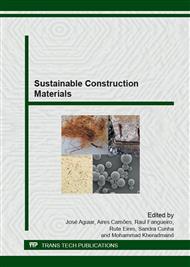p.447
p.455
p.467
p.473
p.479
p.485
p.498
p.506
p.517
Influence of Test Specimens Shape on Measurements of Electrical Resistivity of Concrete
Abstract:
The need to insert the durability factor on dimensioning concrete structures has been stimulating the development of new models to predict the service life of those structures. Among those new models, the use of data from Non-Destructive Testing (NDT) is recommended. It is known that electrical resistivity is a parameter related with permeability and, in consequence, with the resistance of the concrete against the intrusion of aggressive agents. Electrical resistivity may be monitored with time by a NDT method, by a low cost and easy execution technique. However, some parameters of this essay need to be further discussed in the literature aiming to standardize this technique. Thus, this study had the goal to verify the influence of test specimen’s shape in measurements of electrical resistivity. In order to that, cylindrical and prismatic test specimens have been molded from a same type of concrete and electrical resistivity was monitored during a period of 120 days. Results show significant differences between the values obtained. Test specimens in cylindrical shape had the higher results. A good correlation between factors was found with R2 higher than 0.94.
Info:
Periodical:
Pages:
479-484
Citation:
Online since:
December 2014
Authors:
Keywords:
Price:
Сopyright:
© 2015 Trans Tech Publications Ltd. All Rights Reserved
Share:
Citation:


